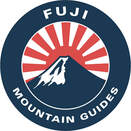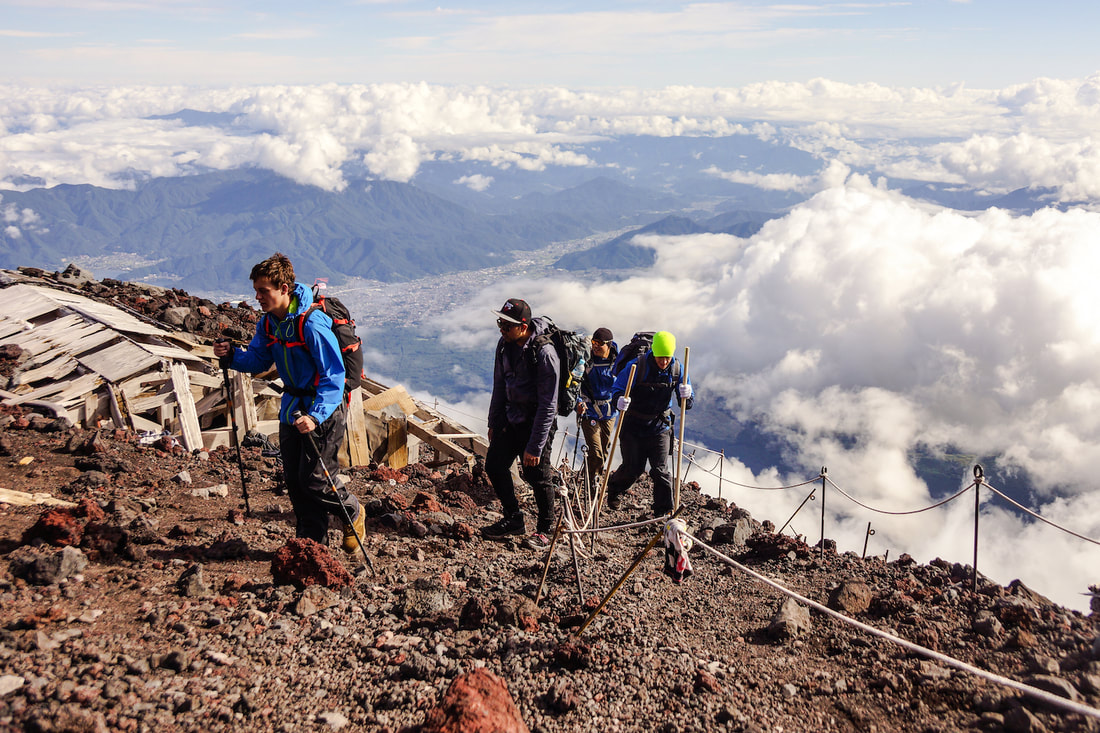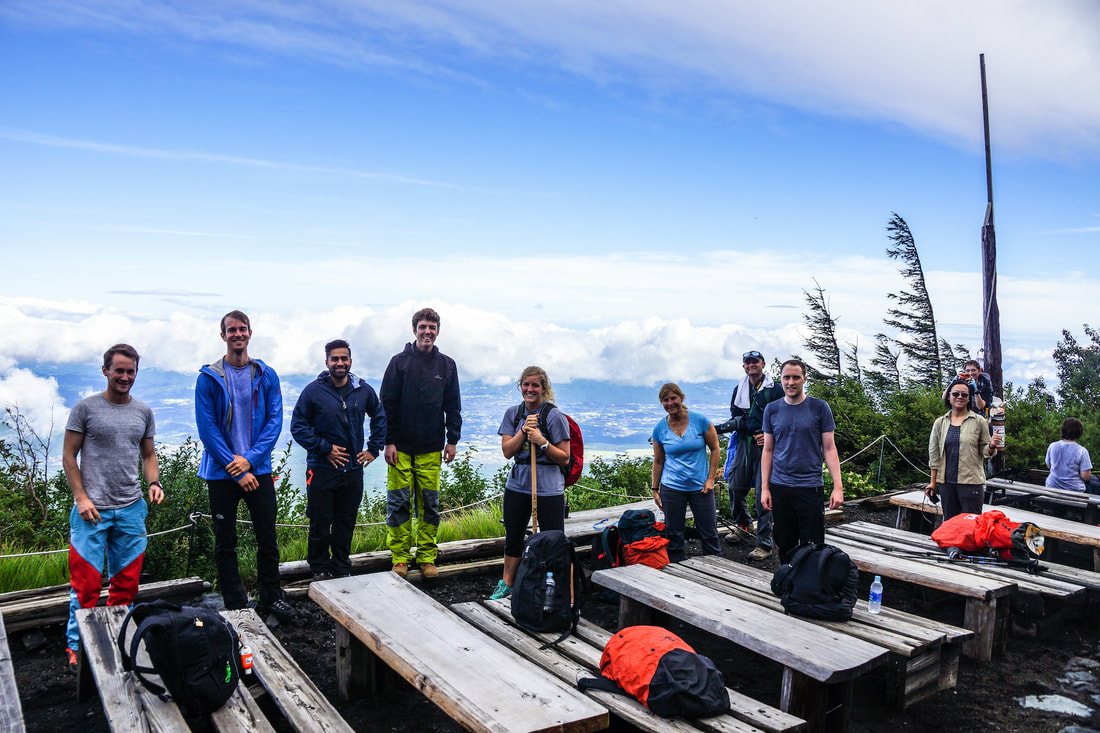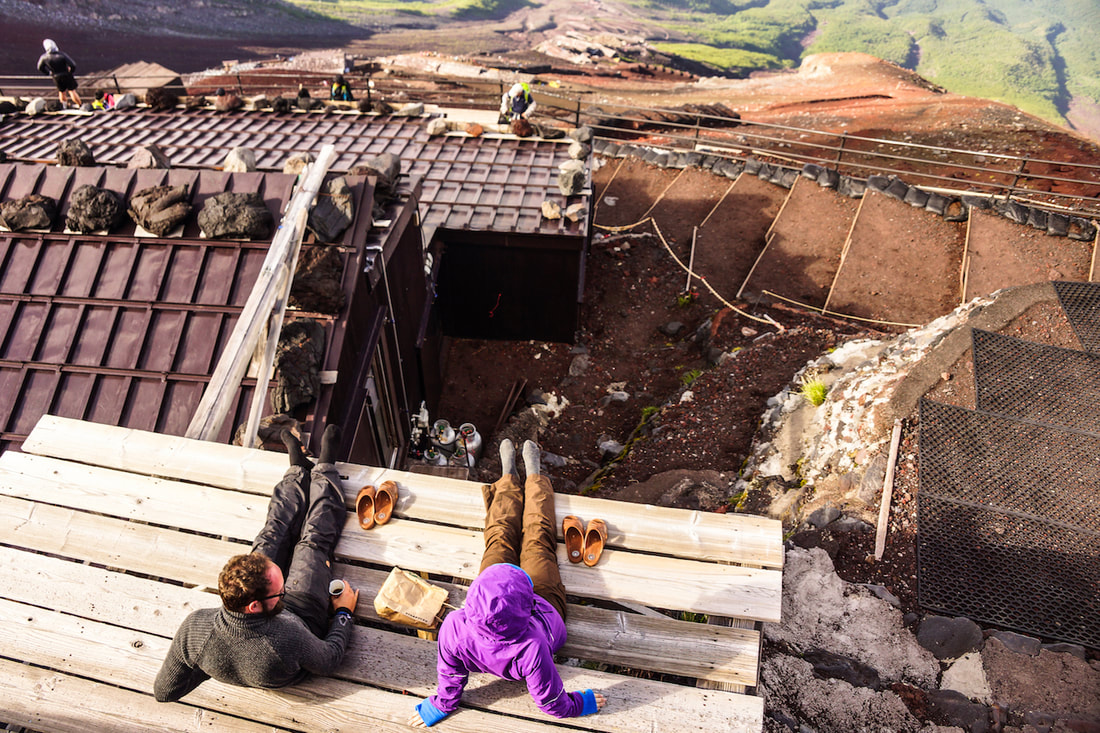Got questions? We've got lots of answers at our online Help Center here. If that doesn't solve your issue, you can also contact us through our Help Center as well!
Mt. Fuji FAQ
This page covers a range of frequently asked questions, split up into four categories: Mt. Fuji Tours, Mountain Huts, Climbing Mt. Fuji, and Climbing Mt. Fuji Off Season. Many of your questions regarding our tours, the climb, or your mountain hut logistics will be answered here. Take some time to navigate through this page and if you've still got questions, feel free to contact us.
Mt. Fuji Tour
Below are frequently asked questions regarding our 2-day Mt. Fuji tour.
Where does the tour leave from and how do I get there?
The tour departure location and time is listed in the itinerary page for each respective tour. Here are links to the Two Day Mt. Fuji Tour itinerary and Off Season Two Day Mt. Fuji Tour itinerary.
All Fuji tours depart in front of Tochomae Station (pronounced "Toe-cho-ma-é) on the Toei Oedo line. How do you get here? Check out our access page here which has very thorough directions on how to get to the meetup point. We'll meet right in front of the only ticket machines inside this station. For those staying in the Mt. Fuji area, there is also the option of getting picked up at Gotemba train station. You can find more information about the Gotemba station pick up on the Gotemba station access page here.
All Fuji tours depart in front of Tochomae Station (pronounced "Toe-cho-ma-é) on the Toei Oedo line. How do you get here? Check out our access page here which has very thorough directions on how to get to the meetup point. We'll meet right in front of the only ticket machines inside this station. For those staying in the Mt. Fuji area, there is also the option of getting picked up at Gotemba train station. You can find more information about the Gotemba station pick up on the Gotemba station access page here.
How do we book a two-day Mt. Fuji tour?
Reservations for our two-day tours can be made through our online booking engine and secure payment processor.
Book the Two Day Tour
Book the Off Season Two Day Tour
Book the Two Day Tour
Book the Off Season Two Day Tour
What happens if I show up to the meeting time late?
Our tours run on "Japan time". This means that we leave promptly at the published departure time. If you are late, the tour will leave without you and your reservation will be forfeited without refund. Please make your greatest effort to show up on time.
What level of fitness should I be in?
Visit our physical fitness guide page and come ready to tackle Mt. Fuji. We have provided a detailed program to help people prepare for their Mt. Fuji ascent.
Will I be able to store baggage anywhere before climbing Mt. Fuji?
Fuji Mountain Guides cannot store extra luggage for you. Options for luggage storage include coin lockers at Shinjuku or Gotemba JR Stations, hotel baggage storage services, or sending by 'takkyubin' (postal service) to your next destination.
What sort of equipment will I need?
Good question. Check out our equipment lists for a complete guide on what to bring on your climb up Mt. Fuji.
Do you offer rental equipment?
We sure do. A full list of our rental equipment may be found here.
How long does it take to get up and down Mt. Fuji?
On our in-season two-day tours, the climb to the summit is spread out over two days. On Day 1 we will hike about 6 km to our lodging for the night (3,400 meters) in about 6-7 hours. From here to the summit on Day 2, it is about a 1 1/2-hour climb and the descent to the 5th station tends to be 3-4 hours. These are just approximations, as the time it takes to hike up and down Mt. Fuji varies from group to group.
What is the tour minimum and maximum group size?
Each and every tour, both in season and off season are operated at a minimum of one participant.
For our in season and off season two day tours, between late June and mid-October, the guide to guest ratio is 1 to 10. Most tours are operated with 3-4 guides and 25+ participants.
For our in season and off season two day tours, between late June and mid-October, the guide to guest ratio is 1 to 10. Most tours are operated with 3-4 guides and 25+ participants.
Do I need to bring my own sleeping bag?
Bedding is provided by our partner mountain huts. Sleeping bags are lined up on top of futon mats, with an extra blanket available for when you get cold. Pillows are also provided, but most westerners find them hard and uncomfortable. Fill your stuff sack with some extra clothes and you've got yourself a makeshift pillow.
Where can I find a weather forecast?
Take a look at our weather forecast page to view a five-day weather forecast on Mt. Fuji. A forecast for 3,014 and 3,776 meters is available, courtesy of snowforecast.com.
However, be aware that conditions on Mt. Fuji may change suddenly. Therefore at FMG we make it a priority to ensure our clients are prepared for cold weather, wind, and rain. Check out our equipment lists for more information regarding proper wear on Mt. Fuji.
However, be aware that conditions on Mt. Fuji may change suddenly. Therefore at FMG we make it a priority to ensure our clients are prepared for cold weather, wind, and rain. Check out our equipment lists for more information regarding proper wear on Mt. Fuji.
When is a good time to join a Mt. Fuji tour?
If you're looking to avoid the crowds, try climbing during the first three weeks of July or sometime in September/October. Join our Off Season Two Day Tour and you will find the trails as well as mountain hut to be almost completely deserted.
During Japanese school summer vacation, approximately July 20 through the end of August, Mt. Fuji takes on an extra amount of pedestrian traffic. Especially avoid weekends and the 'Obon' period (the week of August 13) as most Japanese companies will give their workers vacation during this time.
During Japanese school summer vacation, approximately July 20 through the end of August, Mt. Fuji takes on an extra amount of pedestrian traffic. Especially avoid weekends and the 'Obon' period (the week of August 13) as most Japanese companies will give their workers vacation during this time.
Are there trash cans available?
Trash cans are not available on Mt. Fuji. Climbers are asked to use leave-no-trace methods of “pack it in, pack it out” in an effort to maintain the natural beauty of Mt. Fuji. This is why we require everyone on our tour to bring a ziplock bag or something similar for storing trash and packing it out.
Will there be restrooms?
At each mountain hut there are public restrooms. Toilets on Mt. Fuji cost ¥200-¥300 yen per use. Please have coins handy for whenever you need to use the facilities. The exception is on our Off Season Two Day tours. During this period, all but one mountain hut will be closed and toilet facilities on the mountain other than our lodging will not be available.
How much money should I bring? Are credit cards accepted?
FMG tours include all transportation and lodging costs plus two hot meals (dinner Day 1 and breakfast Day 2). Lunch is also provided on Day 1 of the Off Season Two Day Mt. Fuji Tour.
On our In Season Tour, you will need to provide for yourself two lunches as well as snacks for the climb. If you wish to buy this on the mountain, the average cost for lunch is around ¥1,000. We recommend you buy snacks beforehand as prices are extremely inflated once on Mt. Fuji.
If you are only planning to spend money on lunch, then ¥3,000 will be sufficient. If you wish to also buy souvenirs, it would be wise to bring at least ¥5,000. You must bring cash, as mountain huts on Fuji do not accept credit card.
On our In Season Tour, you will need to provide for yourself two lunches as well as snacks for the climb. If you wish to buy this on the mountain, the average cost for lunch is around ¥1,000. We recommend you buy snacks beforehand as prices are extremely inflated once on Mt. Fuji.
If you are only planning to spend money on lunch, then ¥3,000 will be sufficient. If you wish to also buy souvenirs, it would be wise to bring at least ¥5,000. You must bring cash, as mountain huts on Fuji do not accept credit card.
Can I get my walking stick branded along the way?
Each particular trail on Mt. Fuji sells the traditional walking sticks and at almost every hut, branding is operated. Typically the price for one branding is ¥200. Note that the summit mountain huts are open between mid-July and the end of August, and the summit branding is only available during this time.
Do you offer pick up and drop off in the Mt. Fuji area?
On our in season and off season two day tours, we offer the option of starting and ending our Mt. Fuji tours at Gotemba Station. Depending on your tour, the pick up and drop off time will vary. For more information, including pictures of the pick up spot, visit our Gotemba Station pick up page. You can also see how a Gotemba pick up fits in with the itinerary by clicking on either the Two Day Tour itinerary or Off Season Tour itinerary.
What is the fastest route to Kyoto from Mt. Fuji?
The fastest route to Kyoto from Mt. Fuji is via Gotemba train station. Gotemba train station is best accessed from the Subashiri, Fujinomiya, and Gotemba trails. From Gotemba, travel by train to Mishima Station, from where the Shinkansen (bullet train) departs for Kyoto. If descending the Yoshida trail to Subaru line 5th station, the best option is to travel to Shinjuku by highway bus and connect to the Shinkansen from Tokyo or Shinagawa station.
What is the tour cancellation policy?
Read up on our full Terms and Conditions including our cancellation policy for the Two Day Mt. Fuji Tour and Off Season Two Day Mt. Fuji Tour.
Do you provide guiding services during the off season?
Yes, we provide guiding during the months of September and October, all weather permitting. See our Off Season Two Day Mt. Fuji Tour for more information.
Mountain Huts
Below are frequently asked questions regarding Mt. Fuji mountain huts.
Does FMG assist in making mountain hut reservations?
In cooperation with the Fujiyoshida City Hall, FMG's partner Japan Mountain Huts now takes online reservations for several mountain huts on the Yoshida and Subashiri trails. For more information on this, visit the Japan Mountain Huts site. Please note, mountain hut reservations open at the beginning of April for each prospective season.
Will I need a reservation to stay at a mountain hut?
It is definitely recommended that you make a reservation at a mountain hut if you intend to spend the night on Mt. Fuji. Prices range from ¥6,000-¥10,000 depending on whether your stay falls on a weekday or weekend and if you choose to include dinner and/or breakfast. Making a mountain hut reservation can be difficult due to the language barrier or lack of information about mountain huts online, which is why our partner Japan Mountain Huts offers an English reservation system for select huts here.
Which trail is Fujisan Hotel located on?
Fujisan Hotel can be accessed by both the Yoshida and Subashiri trails and is located at the 8th station, just under Tomoekan and one station below Goraiko-kan.
Where is Taishikan Mountain Hut located?
Taishikan Mountain Hut is located on the Yoshida trail at 3,100 meters, one below Haraikan and one above Toyokan mountain huts. Note that there are multiple 8th stations on the Yoshida trail as both Fujisan Hotel and Taishikan are considered 8th stations but are 300 meters apart from each other.
Are there certain rules/etiquette specific to Mt. Fuji mountain huts?
Absolutely. Mountain huts on Fuji are a unique cultural experience but come with their own set of implied etiquette which foreigners can unwittingly stomp all over if they're not careful.
Take the time to review the information on Mountain Hut Etiquette before you head out on your climb up Mt. Fuji.
Take the time to review the information on Mountain Hut Etiquette before you head out on your climb up Mt. Fuji.
Climbing Mt. Fuji
Below are frequently asked questions regarding climbing Mt. Fuji.
When is a good time to climb Mt. Fuji?
Mt. Fuji is best climbed between late June and the middle of October if you are looking to avoid any snow on the trails. If you want to avoid the crowds, try climbing during the first three weeks of July or sometime in September/October. Join our Off Season Two Day Tour and you will find the trails as well as mountain hut to be almost completely deserted.
During Japanese school summer vacation, approximately July 20 through the end of August, Mt. Fuji takes on an extra amount of pedestrian traffic. Especially avoid weekends and the 'Obon' period (the week of August 13) as most Japanese companies will give their workers vacation during this time.
During Japanese school summer vacation, approximately July 20 through the end of August, Mt. Fuji takes on an extra amount of pedestrian traffic. Especially avoid weekends and the 'Obon' period (the week of August 13) as most Japanese companies will give their workers vacation during this time.
What is the official climbing season for Mt. Fuji?
The official climbing season is said to be from July 1st to August 31st but is subject to change depending on weather conditions. Usually this means that the season starts a little after the first week of July. Most mountain huts are only open during this time, although on the Yoshida trail you will find that most huts are open through to the first week of September. FMG provides guiding services to the summit of Mt. Fuji from June through October. If you wish to climb outside of the official climbing season, see our Off Season Two Day Mt. Fuji Tour.
How many trails are there on Mt. Fuji?
There are four different trails leading up to the summit of Mt. Fuji, each starting from its own separate 5th station. The Subashiri, Fujinomiya, and Gotemba trails are on the Shizuoka side of Mt. Fuji while the Yoshida trail is on the Yamanashi side. Very often you will hear just the words "Mt. Fuji 5th station" without a specific trail defined. This can be confusing, seeing as there is more than one 5th station on Mt. Fuji. Please be aware that "Mt. Fuji 5th station" is primarily used in reference to the Kawaguchi-ko 5th station, which is the largest, most developed 5th station on Mt. Fuji and is connected to the Yoshida trail. Fuji Mountain Guides conducts its tours on the Subashiri trail while sometimes descending using the Yoshida trail.
How difficult is the climb?
Do not believe the blogs that say Mt. Fuji is an easy climb. Make no mistake: at 3776 m/12,388 ft, the climb up Mt. Fuji is characterized by serious elevation gain, rapidly changing extreme weather, steep inclines, and long switchbacks.
This is not a climb that you want to attempt without proper conditioning and physical preparation. While it is true that some people climb Mt. Fuji in sneakers, jeans, and a sweatshirt, they are taking serious personal risks that should never be replicated. Despite weather forecasts, the weather on Mt. Fuji is never 100% guaranteed. This means that unexpected thunderstorms, rain downpours, snow storms, hail storms, and the like are common and should be properly prepared for with proper equipment.
This is not a climb that you want to attempt without proper conditioning and physical preparation. While it is true that some people climb Mt. Fuji in sneakers, jeans, and a sweatshirt, they are taking serious personal risks that should never be replicated. Despite weather forecasts, the weather on Mt. Fuji is never 100% guaranteed. This means that unexpected thunderstorms, rain downpours, snow storms, hail storms, and the like are common and should be properly prepared for with proper equipment.
Is going up or coming down Mt. Fuji more difficult?
This might sound like a silly question; you might think this is a no brainer - that the ascent is obviously more difficult than the descent. Wrong! The correct answer is that ascending and descending Mt. Fuji are equally tiring. The climb up Fuji is steep from start to finish, on average being a 35- to 40-degree angled slope. But it is very important to keep in mind that the summit is merely the halfway point of your climb - you've got to get back down. Save enough energy for the descent, which is surprisingly long and requires a significant amount of energy and leg strength.
On a typical day, what is the temperature at the 5th station and the temperature at the summit? (July/August)
This will depend significantly on the time of day and whether it's sunny, cloudy, or rainy, but typically you can expect summer conditions at the 5th station and winter conditions at the summit. Although on a beautiful blue-sky, sunny, absolutely-no-wind day it might be possible to climb from the 5th station to the summit in shorts and a t-shirt, this is the exception and not the rule. It would be extremely foolish to climb without the proper warm-weather and waterproof rain gear in case of bad weather rolling in, especially when planning to ascend at night.
Take a look at our Mt. Fuji weather page to see a five-day weather forecast on Mt. Fuji, and be aware that conditions on Mt. Fuji may change suddenly. Be sure to come prepared for summer heat, winter cold, wind, and rain. Check out our equipment lists for more info regarding proper wear on Mt. Fuji.
Take a look at our Mt. Fuji weather page to see a five-day weather forecast on Mt. Fuji, and be aware that conditions on Mt. Fuji may change suddenly. Be sure to come prepared for summer heat, winter cold, wind, and rain. Check out our equipment lists for more info regarding proper wear on Mt. Fuji.
What are the prospects for a clear or rain-free day?
Weather patterns are different every year, for each month and each day. There is no way to tell months in advance when the most favorable weather for climbing Mt. Fuji will be. Typically June through the middle of July tends to be the rainy season in Japan, but in some years August will receive more rain on Mt. Fuji than July. September is also traditionally known to be typhoon season in Japan. Again though, some years July, August, or October have received more typhoons than September.
Take a look at our Mt. Fuji weather page to see a five-day weather forecast on Mt. Fuji, and be aware that conditions on Mt. Fuji may change suddenly. Be sure to come prepared for summer heat, winter cold, wind, and rain. Check out our equipment lists for more info regarding proper wear on Mt. Fuji.
Take a look at our Mt. Fuji weather page to see a five-day weather forecast on Mt. Fuji, and be aware that conditions on Mt. Fuji may change suddenly. Be sure to come prepared for summer heat, winter cold, wind, and rain. Check out our equipment lists for more info regarding proper wear on Mt. Fuji.
Climbing Mt. Fuji Off Season
Below are frequently asked questions regarding climbing Mt. Fuji in the off season.
When is considered off season on Mt. Fuji?
Off season climbing refers to the period during which almost all mountain huts on Mt. Fuji have stopped operating. This period usually extends from mid-September through to late June.
Is off season climbing on Mt. Fuji allowed?
Contrary to popular belief, climbing Mt. Fuji outside of the months of July and August is permitted. Upon reaching a Fuji trailhead in the off-season, however, one will encounter signposts that say that the trail is closed. These signs are an indirect way of saying, "Climb Mt. Fuji at your own risk." It is best to note that the risk of climbing Fuji in the off-season increases substantially compared to climbing during the official season.
Between late October and the middle of June, off-season climbing requires the knowledge and use of winter climbing skills and techniques. Especially between November and April, the winds and ice on Mt. Fuji can make for an extremely difficult climb and should not be attempted by novice climbers.
Between late October and the middle of June, off-season climbing requires the knowledge and use of winter climbing skills and techniques. Especially between November and April, the winds and ice on Mt. Fuji can make for an extremely difficult climb and should not be attempted by novice climbers.
What sort of conditions can I expect to see on Mt. Fuji during the off season?
Since the 'off season' on Mt. Fuji takes up the majority of the year, conditions will vary from month to month. Typically winter conditions on Mt. Fuji begin late November and last through to late March/mid-April, depending on the year. During these months Mt. Fuji is a serious climb that should only be undertaken by experienced climbers. The wind conditions near the summit of Mt. Fuji in wintertime are known to be similar to those of peaks over 8,000 meters. The surface turns to ice - like that of a frozen waterfall - hard enough that your ice axe and crampons can't dig in. Temperatures in late February will be around -20 to -30 degrees Celsius with a wind chill of -50 degrees Celsius.
From late April through late June, there will still be snow on the trails leading up to the summit of Mt. Fuji. The risk of avalanches still exists and crampons/ice axes are necessary for a safe climb.
From late April through late June, there will still be snow on the trails leading up to the summit of Mt. Fuji. The risk of avalanches still exists and crampons/ice axes are necessary for a safe climb.
Do I need a permit to climb Mt. Fuji during the off season?
Permits are not required but the prefectural police department requests that a climbing form be filled out and submitted in case of an emergency. This is especially true for those attempting a climb between November and April.
Off Season 2 Day TourSep 9 - Oct 15, 2019Enjoy a more relaxed hike. Avoid the crowds and summit Mt. Fuji during the day instead of just before dawn. All transportation fees, lodging, and three hot meals included.
|
In Season 2 Day Fuji TourJune 25 - Sep 8, 2019Our most popular summer offering. This trip will give you ample time to reach the summit for sunrise. Round trip transportation from Tokyo to Mt. Fuji, two meals, and mountain hut included.
|
Private & Group ToursContact Us for DatesHike with a group of friends, colleagues, or family. We can arrange custom pick ups and drop offs too.
|
|
|
|
Follow us on
|
GIVE the GIFt
|
Home - Tours - Rentals - Mt Fuji - About - Contact Us
Privacy Policy - Terms and Conditions - Gallery - Employment
Privacy Policy - Terms and Conditions - Gallery - Employment
Fuji Mountain Guides
Copyright © 2007-2022
株式会社 Japan Guides Group
Nishi Tokyo, Tokyo, Japan
Copyright © 2007-2022
株式会社 Japan Guides Group
Nishi Tokyo, Tokyo, Japan







